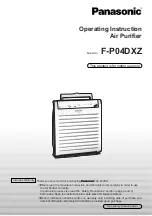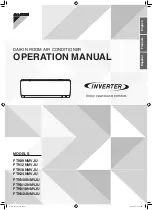
950-0211revA - 9 - March 7, 2014
Service
Port
Installation (CONT’D).
Step 6
Install unit on mounting bracket. Feed the line set stubs/condensate hose/wiring connections through the 3''
hole. Installation can be made easier by lifting the indoor unit and inserting a cushioning material (spacer)
between indoor unit and the wall. Hook the top of the indoor unit to the top of the bracket (2 or 3 places) and
once hooked, gently let it swing down and then push the lower portion of the indoor unit against the bracket
until it snaps into the bracket.
Indoor unit is now installed. It should be plumb, level and flush with the wall. Insure that the line set stubs are
completely through the wall penetration. Also check that the
wall is plumb. The unit must be level and plumb for proper
condensate removal.
Check the drain hose, Observe that the condensate drain
pipe does not curve upward and is in the lower part of the pipe
bundle.
Step 7
OUTDOOR INSTALLATION
Locate outdoor unit. Clearances for the outdoor unit are:
Do not install the outdoor unit in a location exposed to high winds (field fabricated and installed wind baffle may
be required). Ensure location does not impede access around unit and pose a disturbance to neighboring
areas.
Step 8
Refrigerant Line Set Piping
Interconnecting line set between the outdoor unit and the Indoor unit must have both
refrigerant lines insulated as condensing device is located in the outdoor unit.
Gently bend the line set stubs from the indoor unit to the desired location. Using (2)
properly sized wrenches remove the flare nuts from the Indoor unit line stubs.
The indoor unit is filled with a dry gas, check for release of this to ensure that no leaks
are present. Use a small amount of vacuum pump oil on the male flare threads to ease
installation.
Connect the line set to the stubs. Using 2 wrenches, 1 on the male & 1 on the female,
tighten the flare nuts.
DO NOT INSTALL A LIQUID LINE SIGHT GLASS OR FILTER DRIER IN THE
SYSTEM.
Run the line set to the outdoor unit. Avoid tight bends and kinking the lines. It is
not recommended to braze line sets together or to the unit connections.
If line set length is in excess of that required, cut the pipes a little longer than
measured distance. Completely remove all burrs from the cut cross section of
pipes. Follow standard flaring procedures and use proper flaring tools for a leak
proof connection.
Note:
Line set
connections
under the
brass caps











































